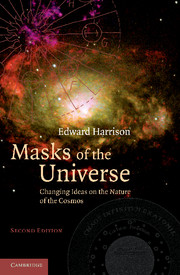Book contents
- Frontmatter
- Contents
- Prefece
- 1 Introducing the Masks
- Part I Worlds in the Making
- Part II The Heart Divine
- 8 Dance of the Atoms and Waves
- 9 Fabric of Space and Time
- 10 What Then is Time?
- 11 Nearer to the Heart's Desire
- 12 The Cosmic Tide
- 13 Do Dreams Come True?
- Part III The Cloud of Unknowing
- Bibliography
- Index
8 - Dance of the Atoms and Waves
Published online by Cambridge University Press: 27 October 2009
- Frontmatter
- Contents
- Prefece
- 1 Introducing the Masks
- Part I Worlds in the Making
- Part II The Heart Divine
- 8 Dance of the Atoms and Waves
- 9 Fabric of Space and Time
- 10 What Then is Time?
- 11 Nearer to the Heart's Desire
- 12 The Cosmic Tide
- 13 Do Dreams Come True?
- Part III The Cloud of Unknowing
- Bibliography
- Index
Summary
In everyday life we deal with things of sensible size – such as flowerpots and plants – and to understand these ordinary things we explore the worlds of the very small and very large. We delve into molecules and atoms and reach out to the stars and galaxies. Thus, we know that most atoms composing the Earth were made in stars that died long before the birth of the Sun.
This wide realm of nature, of things ranging in size from atoms to galaxies, is ruled not by the gods of antiquity, but by the laws of motion and the push and pull of electrical and gravitational forces. Electrical forces dominate on the scale of molecules and atoms, accounting for much of the intricacy of the very small; gravitational forces dominate on the scale of stars and galaxies, accounting for much of the intricacy of the very large. The exploration of this luxuriant garden of phenomena is in the care of physical sciences such as chemistry, biochemistry, geophysics, and astrophysics.
The great problems lying deep at the foundations of the physical universe are no longer found in this realm that stretches from atoms to galaxies. They are found in the outer realms of nature. When the scale of measurement decreases a hundred thousand times smaller than the size of atoms, and increases a hundred thousand times larger than the size of galaxies, we quit the lush middle realm and enter the outer realms. Here we discover the truly baffling.
- Type
- Chapter
- Information
- Masks of the UniverseChanging Ideas on the Nature of the Cosmos, pp. 123 - 140Publisher: Cambridge University PressPrint publication year: 2003



